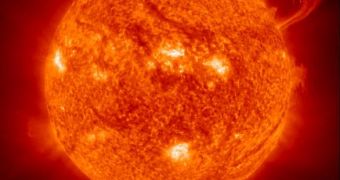New studies reveal that the Sun might be actually smaller than previously calculated. If this is proven to be correct, then all the properties regarding the internal temperature and density could be slightly different and will need recalculating. These are critical in helping scientists make future predictions about the space weather and answer certain questions about the solar system. Just like the gas giants, the Sun has no solid surface.
The surface of the Sun is defined as the line in the depth of the solar atmosphere where it becomes opaque to light. This is measured by observing the distance between the center of the solar disk and the edge. It is estimated that the Sun has a radius of 109 times that of the Earth, 695,990 kilometers.
The second technique used to measure the Sun's size is by observing the surface gravity waves which ripple across its surface, like the waves of water at the ocean's surface. The theory also implies that these gravitational waves will only form on the opaque surface and the wavelengths are directly tied to the radius of the Sun.
The two measuring methods have puzzled scientists for years, due to the fact that they have always given two distinct results. The technique of measuring the radius of the Sun with the help of the gravitational waves always gave a smaller value, around 695,700 kilometers, meaning about 300 kilometers less than the result obtained with the light drop-off technique.
Even a 0.04% difference is significant enough and it matters in the scientists' calculations to obtain crucial information about the conditions in the Sun's interior, by using the helioseismology technique. The helioseimology presents important information about the formation of the solar spots, through which the solar wind and space weather can be appreciated. The technique was also used to partially solve the problem of missing neutrino flowing from the Sun to the Earth, ruling out the possible changes in its interior that could have caused this.
The discrepancy in the difference of the solar radius measured with the two separate methods can be explained by different models showing the way light propagates in the Sun's atmosphere. The calculations were made by a team led by Margit Haberreiter of the World radiation Center in Davos, Switzerland and actually showed through software simulations exactly where the light drop-off should occur. The results revealed that indeed there is a small difference between where the atmosphere becomes opaque and the light drop-off point and the calculated distance shows that the light drop-off will actually occur 333 kilometers higher in the atmosphere than the location of the opaque surface.
The recalculated diameter of the Sun will probably trigger the recalculation of all the other properties regarding its interior. For example, the research shows that the Sun probably contains half the quantity of oxygen that was previously believed.

 14 DAY TRIAL //
14 DAY TRIAL //